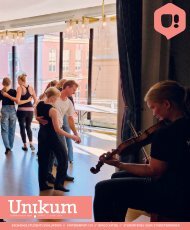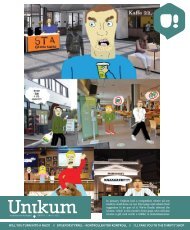DESEMBER_UNIKUM_WEB
You also want an ePaper? Increase the reach of your titles
YUMPU automatically turns print PDFs into web optimized ePapers that Google loves.
DEBATE<br />
Stirred not shaken!<br />
A look at the STIRRED UP debate<br />
about ALCOHOL regulation in Norway<br />
Henrike Jost<br />
Writer<br />
Illustration: AdobeStock // Jeff<br />
For those of us who celebrate, the holidays are right around the<br />
corner, which means endless Christmas and New Year parties with<br />
an even more endless flow of alcohol. While these parties can mean<br />
lots of fun, for others they mean a heightened risk of sexual assault.<br />
These cases are not isolated incidents. One tenth of the Norwegian<br />
workforce have either been sexually assaulted themselves or know<br />
someone who has been subject to such inappropriate behavior at<br />
their company’s Christmas party (Bjørnson Hagen, 2022). To blame<br />
is often the large flow of alcohol that are served and consumed at<br />
the festivities. Alcohol is not only deeply ingrained in Norwegian<br />
and other Nordic countries’ Christmas traditions, but it is said to be<br />
generally interwoven with their cultures for centuries.<br />
The dangers of the widespread heavy drinking patterns across<br />
populations in the North have been used to justify strict regulations<br />
on alcohol production, selling, and consumption that Norway and<br />
its fellow Nordic countries are well known for today. The question<br />
is: Are these stringent rules justified and effective in what they are<br />
trying to achieve? The most recent SHoT study (Studentenes Helseog<br />
Trivselsundersøkelse) has, for example, shown that more than<br />
half of the male university students and 4 in 10 female students<br />
exhibit risky drinking patterns (Heradstveit et al., 2022) and, as<br />
such render the regulatory approach to appear ineffective. So let’s<br />
take a look at the Norwegian approach to regulating alcohol, its<br />
history, and its pros and cons to see whether it actually works and<br />
prevents societal harm or if it is unnecessarily harsh.<br />
A shot of history<br />
The strict regulations on alcohol consumption date back to heavy<br />
alcohol use in the 19th century, reaching its peak in the 1830s with<br />
13 liters of alcohol per person (Hauge, 1996). The general public<br />
saw it necessary to reduce the harm caused by alcohol and started<br />
to call for stricter regulations (WHO, 2023; Karlsson & Österberg,<br />
2003).<br />
In 1919, the Alcohol Prohibition Act was introduced, which<br />
prohibited the consumption and production of the majority of<br />
spirits. However, trade quarrels with wine-exporting countries,<br />
like France and Spain, caused its demise 8 years later (Johansen,<br />
2013).<br />
The Alcohol Act that is in force today was implemented in 1990s<br />
(Karlsson & Österberg, 2003). Its main objective remains to be the<br />
same as the initial approach to alcohol regulation: to reduce health<br />
and societal harm caused by alcohol. The new act tries to reconcile<br />
this goal while also allowing citizens to choose whether they want<br />
to consume liquor (Götestam & Röstum, 1983).<br />
Today’s offer: the legal cocktail<br />
It is widely held that the way regulating alcohol is approached<br />
has significant impact upon how much harm is caused by liquor<br />
(Götestam & Röstum, 1983). Therefore, the government opted for a<br />
rather strict approach to prevent societal and health related harms<br />
such as accidents caused by drunk driving, as well as alcoholism,<br />
and over 200 other diseases and conditions like cancer (WHO,<br />
2023).<br />
To reduce consumption, only alcoholic beverages below a 4.7%<br />
alcohol concentration can be sold in normal stores. Beverages<br />
above that percentage can only be bought at Vinmonopolet, a store<br />
owned by the state. Through these shops and through the state<br />
monopoly on alcohol, the government can control the access to<br />
purchasing alcohol, its price, as well as which kind of alcohol is<br />
sold (WHO, 2023). The beverages are also highly taxed to further<br />
disincentivize alcohol consumption (Karlsson & Österberg, 2003). A<br />
prohibition of advertising alcohol also falls under the tight alcohol<br />
regulation in Norway (Götestam & Röstum, 1983). In addition,<br />
a license is needed to sell alcohol. Its issuance is decided by the<br />
municipalities (Karlsson & Österberg, 2003).<br />
There are not only restrictions to where alcohol can be bought, but<br />
also for when. Low-percentage alcohol can only be sold between<br />
08:00-20:00 on weekdays, and 08:00-18:00 on Saturdays and the day<br />
before public holidays. Vinmonopolet is only open between 10:00-<br />
<strong>DESEMBER</strong> 2023 <strong>UNIKUM</strong> NR 10 11

















